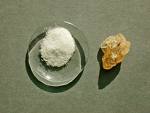Green Stone > Products > Herbal Extracts > Views
Gum acacia
[
customers have already purchased this product.]


Product name: Gum acacia
Product description:
Gum arabic, also known as gum acacia, chaar gund, char goond or meska, is a natural gum made of hardened sap taken from two species of the acacia tree; Acacia senegal and Acacia seyal. The gum is harvested commercially from wild trees throughout the Sahel from Senegal and Sudan to Somalia, although it has been historically cultivated in Arabia and West Asia. Gum arabic is a complex mixture of polysaccharides and glycoproteins that is used primarily in the food industry as a stabilizer. It is edible and has E number E414. Gum arabic is a key ingredient in traditional lithography and is used in printing, paint production, glue, cosmetics and various industrial applications, including viscosity control in inks and in textile industries, although cheaper materials compete with it for many of these roles.
Gum arabic's mixture of saccharides and glycoproteins gives it the properties of a glue, and binder which is edible by humans. Other substances have replaced it in situations where toxicity is not an issue, as the proportions of the various chemicals in gum arabic vary widely and make it unpredictable. Still, it remains an important ingredient in soft drink syrups, "hard" gummy candies such as gumdrops, marshmallows and M & M's chocolate candies. For artists it is the traditional binder used in watercolor paint, in photography for gum printing, and it is used as a binder in pyrotechnic compositions. It has been investigated for use in intestinal dialysis. Pharmaceuticals and cosmetics also use the gum as a binder, emulsifying agent and a suspending or viscosity increasing agent.
It is an important ingredient in shoe polish, and can be used in making homemade incense cones. It is also used as a lickable adhesive, for example on postage stamps and cigarette papers. Printers employ it to stop oxidation of aluminium printing plates in the interval between processing of the plate and its use on a printing press
Gum arabic's mixture of saccharides and glycoproteins gives it the properties of a glue, and binder which is edible by humans. Other substances have replaced it in situations where toxicity is not an issue, as the proportions of the various chemicals in gum arabic vary widely and make it unpredictable. Still, it remains an important ingredient in soft drink syrups, "hard" gummy candies such as gumdrops, marshmallows and M & M's chocolate candies. For artists it is the traditional binder used in watercolor paint, in photography for gum printing, and it is used as a binder in pyrotechnic compositions. It has been investigated for use in intestinal dialysis. Pharmaceuticals and cosmetics also use the gum as a binder, emulsifying agent and a suspending or viscosity increasing agent.
It is an important ingredient in shoe polish, and can be used in making homemade incense cones. It is also used as a lickable adhesive, for example on postage stamps and cigarette papers. Printers employ it to stop oxidation of aluminium printing plates in the interval between processing of the plate and its use on a printing press
Category

Recommend products









Send to this supplier
1. Email: sales@Greenstoneswiss.com
2. Tel: +86 592 5365887
3. WhatsApp: +86 189 6515 7632
4. Send enquiry online:
Customer also maybe viewed the follwing products
Product Image
Product Name
Calcium sulfate
Pyridostigmine Deuterated
Lauryl glucoside
Agrimory Extract
CAS NO.
Order